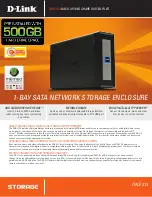
80
Installation
New user setup
This product does not provide default users. When you first connect to the system, you will be prompted to set up a
new user with
manage
capability.
NOTE: At start up, the CLI (Serial/SSH) and WBI (HTTPS) are the only interfaces through which the system
can be configured until the new user is created.
If you connect to the CLI console via the USB port, the following interactive shell output will be presented for
creating a new user.
System Version:
OS Version: xxxxxxx
MC Version: xxxxxxx
Serial Number: xxxxxxx
Login: setup
Password: <empty>
System Name: Uninitialized Name
System Location: Uninitialized Location
Version: No Bundle Version
This system has been factory configured. You must create a new user to manage this system. You
will be asked to provide a username and password. Once the password is confirmed, the system will
automatically log you in with your new user credentials in order to continue setting up the
system. Would you like to continue? (y) y
Enter username>
<New Username>
Enter Password>
<password>
Confirm password> <password>
The shell will prompt you up to three times for a valid user name, and up to three times for a valid and matching
password. If you do not enter a valid user name or password in those attempts, the shell will disconnect and you
will have to log in again.
The newly-created user will have
manage
,
standard
, and
monitor
roles.
Obtaining IP values
You can manually set static IP values (default method) for each controller, or you can specify that IP values should
be set automatically for both controllers through communication with a Dynamic Host Configuration Protocol
(DHCP) server.
TIP:
See the topic about configuring controller network ports in the Storage Manager Guide.
Setting network port IP addresses using DHCP
In DHCP mode, network port IP address, subnet mask, and gateway values are obtained from a DHCP server if one
is available. If a DHCP server is unavailable, current addressing is unchanged. You must have some means of
determining what addresses have been assigned, such as the list of bindings on the DHCP server.
















































